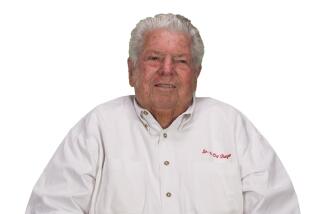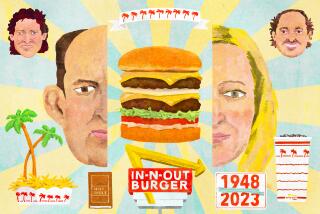International House of Pancakes : Flapjack Chain Tries Flip-Flop of Image
- Share via
“Man Does Not Live by Pancakes Alone.”
Indeed, neither does North Hollywood-based IHOP Corp., parent of the 464-restaurant International House of Pancakes chain, which uses the slogan in its latest promotional campaign.
IHOP has struggled for years to expand its lunch and dinner trade while maintaining its breakfast niche. As fast-food hamburger restaurants try to gain ground in the breakfast market, IHOP is going the opposite route.
“People take the time for leisurely breakfasts during the weekends, and our traffic is fine then,” said Richard K. Herzer, the company’s chairman and president. “During the week, too many don’t think of us and go to McDonald’s.”
Neal Kaplan, an analyst for Interstate Securities of Charlotte, N.C., said: “IHOP’s always served stuff other than pancakes. The company’s trouble is nobody’s ever noticed.”
Heavy Debt Adds to Problems
Even so, non-breakfast items at IHOP now account for 40% of sales, up from 20% in 1982. IHOP says the increase stems in part from a more creative lineup of sandwiches and salads, including the Parmesan-Grilled Beef ‘N’ Cheddar introduced this year.
But company officials say IHOP’s mission is complicated by the heavy debt incurred during the rapid expansion attempted by its founder, Al Lapin Jr., and his successor, Austrian restaurateur Friedrich Jahn, which left the company teetering on the verge of bankruptcy.
Neither Lapin nor Jahn could be reached for comment.
The firm still is 100% owned by a Swiss holding company consisting of Jahn’s creditor bankers, but it has been profitable since 1983. IHOP says it earned $3.4 million in 1985 on sales that climbed 14% from two years before to $242 million.
Luckily for the company, pancakes are said to be enjoying a resurgence among baby boomers. The supposedly health-conscious generation views pancakes as a treat the same way it does yuppie brands of cookies and ice cream, said Stephen T. Pettise, IHOP marketing vice president. According to New York-based Restaurant Business magazine, pancake sales surpassed $1 billion last year, up 27% since 1980.
To exploit that trend, the company added two new pancake flavors this year: The Super-Amazin’ Cinnamon Raisin Pancake, which it has promoted heavily on television, and Banana Nut, one of the original 48 flapjack varieties eliminated in the 1970s, when the chain pared its choices to 16.
Concentrated in Five Metropolitan Areas
New lunch and dinner offerings include the Super Stack, which is ham, turkey and Swiss cheese on a French roll; the Big Cheese, a sandwich with Cheddar, jack and Swiss cheese; tomato and bacon on cracked wheat, and taco and seafood salads.
Although franchises are in 35 states, IHOPs chiefly are concentrated in five metropolitan areas: New York, Atlanta, Chicago, Dallas and Los Angeles. The company owns 89 restaurants; the other outlets are franchises.
Nearly 16,000 people work at the restaurants in both categories, and 180 work in IHOP’s sparse, two-story headquarters, encircled by auto repair shops on Lankershim Boulevard.
The number of franchises has remained fairly flat in recent years, but Herzer says he hopes to have 2,000 within the next 10 to 15 years. Herzer, 55, who keeps on his desk an IHOP cup and a coffee pot resembling those in the restaurants, maintains that despite corporate problems, the IHOP restaurants have always been profitable.
Competition in IHOP’s market comes from La Mirada-based Denny’s Inc., which has more than 1,200 Denny’s restaurants as well as about 850 Winchell’s Donut Houses in the United States and abroad.
Other competitors range from neighborhood diners to regional chains such as Marriott Corp.’s Bob’s Big Boy in Western states and Holiday Corp.’s Perkins Restaurants, mostly in the Midwest.
Much has remained the same at International House of Pancakes restaurants since Lapin built the first one in Toluca Lake in 1958. Lapin’s idea was to create a family restaurant in the spirit of the successful hamburger, doughnut and ice cream establishments of the era.
Its trademark, of course, was pancakes, and every table in the chalet-style restaurants had syrups that customers weren’t likely to have in their own kitchens, with flavors such as boysenberry, blueberry and strawberry, and a “never empty” pot of coffee.
The idea worked, and the concepts have stayed basically the same, although many franchises are redecorating with light-colored wallpaper and brass lamps. New restaurants are no longer being built with A-frame roofs, either.
Rapid expansion in the 1960s brought problems. Laden with debt, the company announced substantial layoffs in October, 1970, when several European lenders called in $5 million, half of its outstanding loans to the banks.
In 1976, the company was reorganized by its creditors, 21 banks and an insurance company, and renamed IHOP Corp. Three years later, IHOP was sold to Wienerwald Holding AG of Switzerland, which was owned by restaurateur Jahn. Herzer was named president and Jahn became chairman.
Under Jahn, the chain expanded its non-breakfast menu from what Herzer now calls “relatively uninspired” items such as hamburgers and french fries to Germanic specialties including bratwurst, schnitzel and sauerkraut.
“Friedrich thought everybody liked the food he liked,” Herzer said. “But those items didn’t work.”
Herzer takes credit for helping to revitalize the chain in 1982 by introducing 17 new dinner items, including steak, roast chicken and shrimp.
Jahn, meanwhile, was struggling with personal business problems that led to his losing ownership of the pancake chain in March, 1983, to a Zurich holding company.
“We talk with them every six months or so, but so long as we keep making money, we don’t hear from them,” Herzer said.
Larry A. Kay, senior vice president, said the holding company has always intended to sell IHOP sometime and divide the proceeds. “But it’s not going to be a fire sale. Unlike U.S. banks, the Europeans can hold on to us indefinitely, until they feel they can get the right price.” Kay also wouldn’t rule out a leveraged buyout but said such a plan was unlikely because of the firm’ heavy debt.
More to Read
Inside the business of entertainment
The Wide Shot brings you news, analysis and insights on everything from streaming wars to production — and what it all means for the future.
You may occasionally receive promotional content from the Los Angeles Times.










